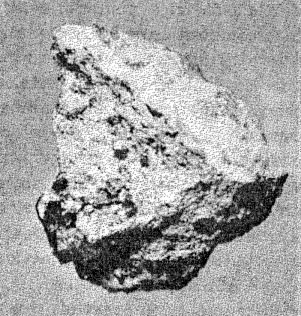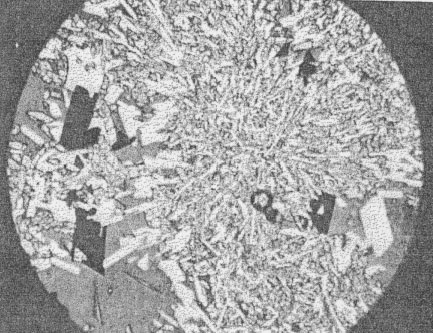| Home | AmMin | GMR | RiMG | Collectors Corner | Directory | Short Courses | |
|
|
|||||||

|
|
Volume 32, pages 105-110, 1947 CRYSTALLIZATION PHENOMENA IN VOLCANIC EJECTA FROM KILAUEA, HAWAII RANDOLPH W. CHAPMAN, The Johns Hopkins University, Baltimore, Maryland. ABSTRACT Blocks of glass-bearing basalt, ejected from Kilauea volcano during the explosive eruption of 1924, contain principally microphenocrysts of olivine and variolitic structures composed of labradorite and augite, with a considerable quantity of interstitial basaltic glass. The texture of the rock and the paragenetic relations of its minerals evince three distinct stages of congelation. INTRODUCTION The eruption of Kilauea volcano on Hawaii in May 1924 was of particular interest because it involved many violent explosions, phenomena not common to Kilauean activity. In fact, this was the first explosive activity that had occurred at Kilauea since the year 1790, and it has not been repeated since. The activity has been described in detail by Jaggar and Finch (1924) and by Finch (1943). During the 1924 eruption a large number of angular blocks of lava were expelled from the volcano's orifice and scattered over the floor of the caldera around the great firepit, Halemaumau. For the most part, these blocks vary in size from small fragments up to one rock which weighed 10 tons (Stearns and Clark, 1930, p. 117 and pl. 20c), but R. H. Finch has informed the writer of one exceptionally large block that weighed 13 tons. They were torn from the walls of the vent by the eruption and the majority were undoubtedly crystalline when ejected. The blocks show a variety of textures and mineral assemblages, resulting, apparently, from different conditions of crystallization. Macdonald (1944 b) has already described several of these blocks, some of which differ radically from typical Hawaiian basalts in having peculiar olivine phenocrysts and a hornfels-like groundmass of labradorite, hypersthene, and augite. In January, 1946, the writer, accompanied by R. H. Finch and Guy C. Omer, Jr., of the Hawaiian Volcano Observatory, visited the floor of Kilauea caldera in the vicinity of the firepit, Halemaumau. They collected several of these blocks, ejected in the 1924 eruption, which show interesting petrographical features. One particular rock type consists of irregular masses of blue-black basaltic glass set in a fine-grained network of plagioclase and ferromagnesian minerals. Due to the fact that basaltic glass has not been previously reported from the ejected blocks of the 1924 explosion, and to the fact that this particular rock type reveals an interesting crystallization history, it was deemed advisable to subject it to special study. The results of this study are presented herewith. The writer is greatly indebted to R. H. Finch and Gordon A. Macdonald for their critical reading of the manuscript and for their helpful suggestions. PETROGRAPHIC NATURE OF THE BASALT The glass-bearing basalt is a heavy, fine-grained, medium-gray rock with what appears at first glance to be a diabasic texture. Close inspection, however, reveals the presence of numerous small radiating intergrowths, averaging 3 millimeters in diameter, made up by the radial arrangement of mineral grains. These radial intergrowths give the rock a variolitic structure which is apparently not uncommon in Hawaiian lavas (Cross, 1915, p. 13; Washington, 1923, p. 344; Stone, 1926, pp. 18-19; Macdonald, 1944 a, p. 183). Scattered throughout the crystalline groundmass are irregular patches of blue-black, vesicular basaltic glass, some patches as much as 12 millimeters across. This glass shows a highly vitreous lustre and a faint iridescence, and has good conchoidal fracture. A photograph of the glass-bearing basalt as it appears in hand specimen is shown in Fig. 1. In thin section the glass-bearing basalt consists of microphenocrysts of olivine and a little pyroxene set in a groundmass of plagioclase, pyroxene, and basaltic glass, with minor accessories. The olivine and pyroxene microphenocrysts are scattered irregularly throughout the rock, but the plagioclase and most of the pyroxene are arranged radially forming little variolitic structures whose diameters average about 3 millimeters. The texture of the basalt is typically intersertal with volcanic glass filling the interstices between mineral grains. These relations are shown in Fig. 2. The olivine microphenocrysts are nearly square in cross section and about 1; millimeters on a side, and in some cases show the effects of magmatic resorption. One microphenocryst showed resorption and the later deposition of a narrow rim of pyroxene similar to the pyroxene in the groundmass. Most microphenocrysts show sieve structure with slender laths of plagioclase perforating them quite unconcernedly. Optical study proves the olivine to be biaxial negative with 2V=85°, β=1.696, and r<v weak. These data, when applied to Winchell's (1933, p. 191) graph for the olivine series, indicate a chemical composition of approximately 75 per cent forsterite, which composition is fairly typical for the olivine phenocrysts in Hawaiian lavas (Aurousseau and Merwin, 1928, p. 560).
Plagioclase is present in slender rod-shaped crystals whose lengths range from 0.2 millimeter to 2.0 millimeters. The lengths of the crystals are from 5 to 8 times their widths. Together with subhedral grains of pyroxene, the plagioclase laths form variolitic structures with an average diameter of 3 millimeters, and these compose the "framework" of the rock. These structures are illustrated in Fig. 2. All plagioclase laths are twinned polysynthetically but do not show zoning. In the zone perpendicular to the side pinacoid their maximum extinction is 35°, revealing a chemical composition of Ab37An63 (labradorite). Pyroxene in small subhedral to anhedral crystals, averaging from 0.1 to 0.5 millimeter in length, is characteristically associated with the labradorite in the radiating structures , already described. However, pyroxene also occurs as small grains scattered at random throughout the groundmass and also as a few microphenocrysts. The pyroxene associated with labradorite and that in the groundmass shows a faint greenish color but is non-pleochroic. It possesses the following optical properties: Biaxial positive, 2V=52°, γ =about 1.725, Z^c= 44°. When applied to Winchell's (1933, p. 227) graph, this indicates augite with a composition of approximately 20 per cent clinoenstatite, 25 per cent diopside, and 55 per cent hedenbergite. Brown basaltic glass, containing minute particles of iron ore, fills the interstices between the above minerals, and, in addition, occupies large irregular areas in the groundmass. It represents the final step in congelation of the basalt. The index of refraction of the glass is 1.555 indicating a silica content of 53 per cent (George, 1924, p. 365). Magnetite and ilmenite occur as accessory interstitial masses, molded between crystals of labradorite and augite, and scattered throughout the, groundmass. Tiny accessory needles of apatite are inclosed in basaltic glass. A modal analysis of the glass-bearing basalt was made with a Wentworth integrating stage and the results are shown below:
Mineral
Percentage
The age relations of the constituents of the basalt have been established as follows: Olivine was an early mineral to crystallize since it forms microphenocrysts, some of which were later partially resorbed by the cooling magma. Some labradorite apparently crystallized either contemporaneously with or slightly earlier than the olivine, since it exists as slender laths inclosed within the latter. Some of the augite was later than olivine for in at least one case it borders a resorbed crystal of that mineral. Although a little augite occurs as microphenocrysts and as irregular crystals in the groundmass, most of it is closely associated with labradorite in radiating, variolitic structures. The majority of the labradorite and augite formed contemporaneously. Magnetite and ilmenite were later than either labradorite or augite, since they occur interstitially between the latter. Slender needles of apatite are inclosed in basaltic glass and are thus older. Inasmuch as glass fills the interstices between crystals, it was the latest constituent to form. COOLING HISTORY OF THE BASALT The texture of the basalt and the paragenesis of its minerals suggest that the normal basaltic magma, from which it was apparently derived, passed through 3 distinct stages in the process of cooling. Stage 1. During this stage the magma is thought to have been located at considerable depth below the surface where cooling was slow and undisturbed. Microphenocrysts of olivine and a few of augite formed in the cooling melt, and the absence of zoning in these microphenocrysts suggests that their re-working by the magma was essentially complete. Labradorite crystals were precipitated in this early stage also, and many became encased in the microphenocrysts. In the later part of this stage, some of the microphenocrysts were partially resorbed,' and in one case a narrow rim of augite was deposited about a microphenocryst of olivine. Stage 2. This stage began when the above magma was intruded into the hot walls of the Halemaumau firepit, possibly as the small sill-like body described by Macdonald (1944 b, p. 322). Here the cooling of the now rather viscous magma was more rapid than in Stage 1, and labradorite laths and augite crystals formed in radial growths about numerous geometric centers throughout the magma. At the conclusion of this stage the rock consisted of a definite crystal mesh with radial, variolitic structures forming the "framework," and with magnetite, ilmenite, and apatite as accessory minerals. Stage 3. In this final stage of cooling, portions of the sill-like intrusion were torn violently from the wall of Halemaumau firepit by explosive eruptivity and hurled high into the air. Thus the residual liquid in the pore spaces was chilled to a glass, and the congelation of the basaltic lava was complete.
REFERENCES AUROUSSEAU, M., AND MERWIN, H. E., Olivine: I. From the Hawaiian Islands; II. Pure forsterite: Am. Mineral., 13, 559-564 (1928). CROSS, W., Lavas of Hawaii and their relations: U. S. Geol. Surv., Prof. Paper 88, 97 pages (1915). FINCH, R. H., Lava surgings in Halemaumau and the explosive eruptions in 1924, Volc. Letter, no. 479 (1943). GEORGE, W. O., The relation of the physical properties of natural glasses to their chemical composition: Jour. Geol., 32, 353-372 (1924). JAGGAR, T. A., AND FINCH, R. H., The explosive eruption of Kilauea in Hawaii, 1924: Am. Jour. Sci., 5th series, 8, 353-374 (1924). MACDONALD, G. A., The 1840 eruption and crystal differentiation in the Kilauean magma column: Am. Jour. Sci., 242, 177-189 (1944 a). ___________________, Unusual features of ejected blocks at Kilauea volcano: Am. Jour. Sci., 242, 322-326 (1944b). STEARNS, H. T., AND CLARK, W. O., Geology and water resources of the Kau District, Hawaii: U. S. Geol. Surv., Water Supply Paper 616, 194 pages (1930). STONE, J. B., The products and structure of Kilauea: B. P. Bishop Mus., Bull. 33, 59 pages (1926). WASHINGTON, H. S., Petrology of the Hawaiian Islands; III Kilauea and general petrology of Hawaii: Am. Jour. Sci., 6, 338-367 (1923). WINCHELL, A. N., Elements of Optical Mineralogy, Part II, Descriptions of Minerals, John Wiley and Sons, Inc. (1933).
|

